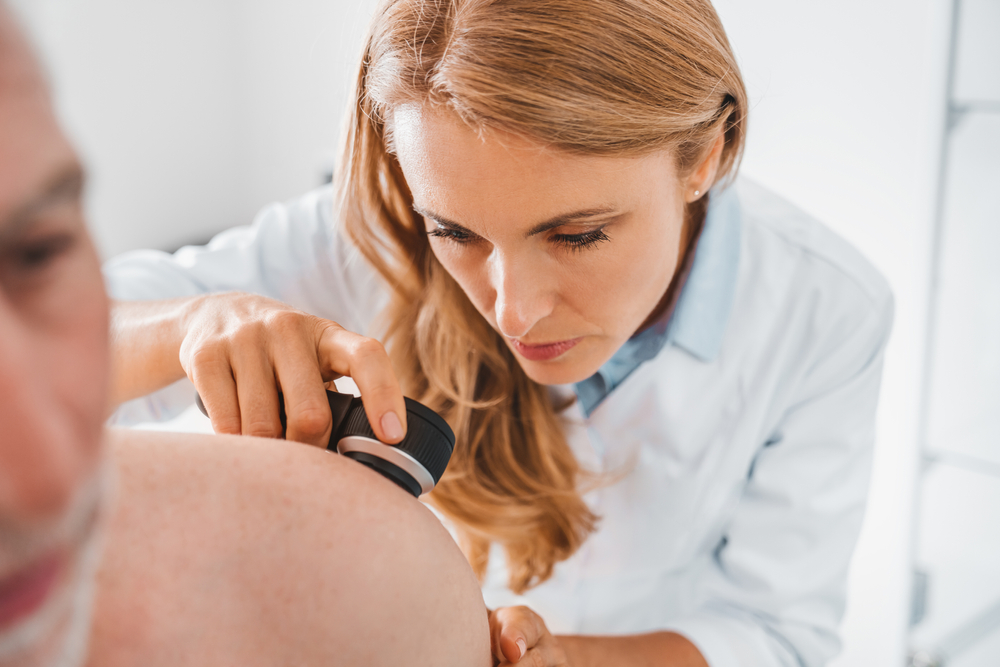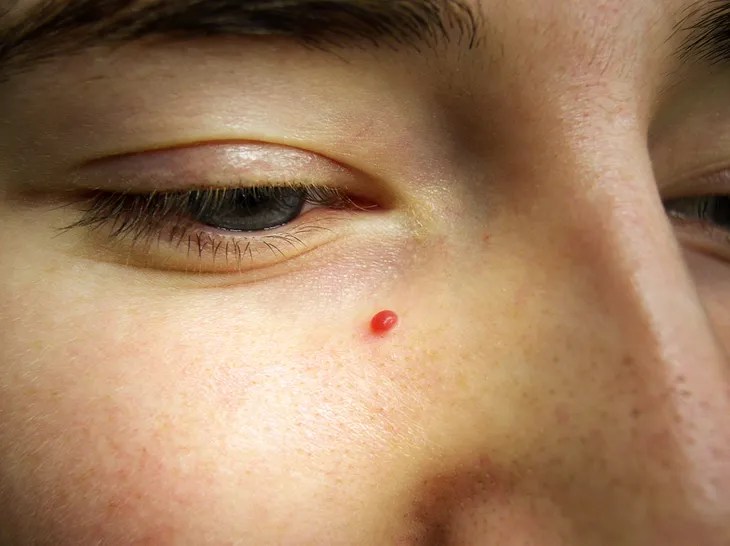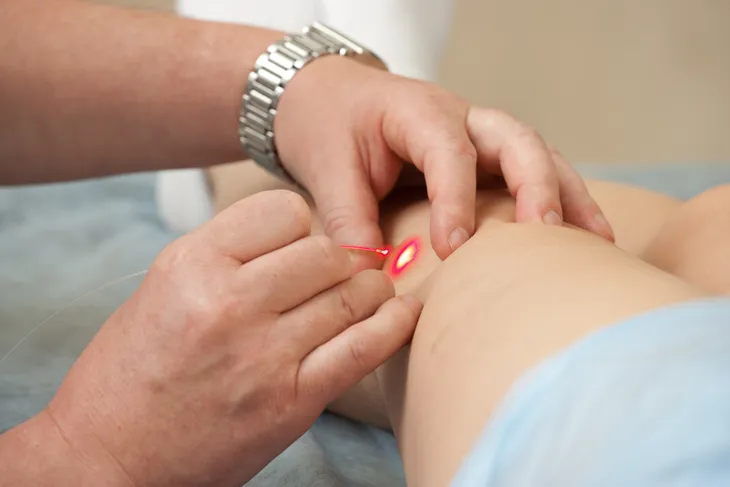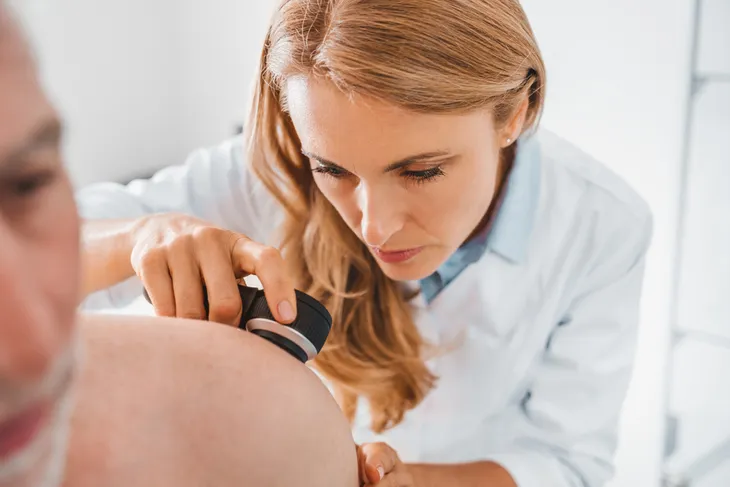- Capillary hemangiomas in adults are usually small and painless.
- These bright red lesions are generally harmless and don’t require treatment unless they make you feel self-conscious.
- Consult your doctor if your capillary hemangioma changes in appearance or you experience a sudden outbreak of multiple lesions.
- There are various surgical options to remove capillary hemangiomas for cosmetic reasons.
Capillary hemangiomas, or “strawberry” birthmarks, are bright red lesions that are most common in babies and children, though you can develop the condition at any age. In adults, capillary angiomas are usually small, red spots that can appear anywhere on the body and don’t disappear over time. These lesions are often called cherry angiomas and are particularly common in older adults. In fact, one study found that 75-percent of seniors over the age of 75 have them.
Capillary hemangiomas are usually nothing to worry about, although there are some circumstances when you should seek medical advice. You can also have capillary hemangiomas removed if they make you feel self-conscious. This article explores what causes these benign (non-cancerous) tumors in adults, the treatment options, and when to see a doctor about skin lesions.
What Causes Capillary Hemangiomas?
Capillary hemangiomas occur when capillaries (tiny blood vessels) form a clump under the skin’s surface, giving it a red appearance. However, doctors don’t fully understand why some adults get capillary hemangiomas. It’s thought that injuries can sometimes cause hemangiomas, although the link is unproven. Certain genetic mutations and older age can increase your chances of developing capillary hemangiomas.
Pregnancy can sometimes cause capillary hemangiomas, and these usually fade after giving birth. Certain illnesses and medications can cause a condition called eruptive cherry hemangiomas, where multiple lesions appear over a short period.
 novak.elcic / Shutterstock
novak.elcic / ShutterstockCommon Symptoms of Capillary Hemangiomas
Capillary hemangiomas aren’t usually painful. They appear as small circular or oval red spots on the skin, most often on the torso, limbs, and shoulders. However, they can also be bluish or purple. Most people with capillary angiomas have several on different parts of their body.
Capillary hemangiomas are normally much smaller in adults than in children, ranging from the size of a pinprick to a pencil eraser. Some capillary hemangiomas are flat, while others form a raised bump or grow on a stalk. Raised capillary hemangiomas can catch on clothing, which can lead to soreness and bleeding.
Diagnosis
It’s relatively straightforward to diagnose capillary hemangiomas in adults, and doctors can usually make a diagnosis based on the skin’s appearance. However, some capillary hemangiomas have a similar appearance to other conditions, such as basal cell carcinoma (a type of skin cancer).
Your doctor may order tests to confirm a diagnosis of capillary hemangioma if they’re unsure. The most common test is a skin biopsy, which involves removing a small sample of the skin cells and examining it under a microscope. Your healthcare provider may also perform blood tests if they suspect an alternative cause.
Treatment
Capillary hemangiomas are almost always harmless and don’t require treatment. However, you may prefer to have your capillary hemangiomas removed if they make you feel self-conscious or keep catching on your clothing or jewelry.
Capillary hemangioma removal is usually a purely cosmetic procedure, so your health insurance may not cover the procedure unless your doctor recommends it. For example, a doctor may advise removal if the hemangioma is bleeding or you notice changes in its appearance.
Excision
Excision surgery is sometimes used to remove capillary hemangiomas. During the procedure, the surgeon numbs the area around the lesion with a local anesthetic and removes the hemangioma away from the skin with a scalpel.
Excision surgery is an outpatient procedure. Some people experience pain and bleeding in the days following surgery, and you should follow your doctor’s instructions on how to care for your wound. You may have a small scar on the excision site.
Electrocautery
Electrocautery, also known as electrodissection, is an alternative surgical technique for removing capillary hemangiomas and other types of skin lesions. After injecting the area with a local anesthetic, the doctor uses an electric needle to burn away the blood vessels and remove the discolored patch of skin. Finally, they apply a dressing to protect the wound.
You might feel some pain after an electrocautery procedure. The procedure usually leaves a small, white scar where the hemangioma used to be.
Laser Removal
Laser removal is another common treatment option for removing capillary hemangiomas. The procedure involves targeting a laser beam at the blood vessels that form the hemangioma.
A single treatment session is sometimes sufficient to remove smaller capillary hemangiomas, but most people require two or more treatments. After your procedure, you may notice your hemangioma turning gray or darker in color before slowly fading in the following weeks. You should cover your skin in the weeks leading up to and following treatment to protect it from the sun.
Cryosurgery
Occasionally, a doctor may recommend a technique called cryosurgery to remove capillary hemangiomas. The procedure involves applying liquid nitrogen to the affected area using a spray or swab, which freezes the tissue and removes the growth.
Most people experience blistering covering the capillary hemangioma before it eventually drops off. Sometimes, the treated area scabs over while it heals. Generally, cryosurgery is a less effective treatment option than excision, electrocautery, or excision surgery, although it’s significantly less expensive.
 Shutterstock/Peera_stockfoto
Shutterstock/Peera_stockfotoHome Remedies
You should never try to remove a capillary hemangioma at home. Cutting, burning, or freezing your skin can cause significant pain and bleeding and potentially lead to a bacterial infection. You’re also significantly more likely to experience scarring if you remove your hemangioma yourself. It’s best to consult your doctor if you want to remove your capillary hemangiomas for cosmetic reasons.
There are several home remedies purported to remove capillary hemangiomas, such as applying iodine or tea tree oil to the skin. While these treatments are unlikely to do any harm, there’s no scientific evidence that they work.
Capillary Hemangioma vs. Spider Angioma: What’s the Difference?
It’s easy to confuse a capillary hemangioma for a spider angioma because both lesions have a similar red appearance. However, a capillary hemangioma generally has a defined border, while a spider angioma has threadlike red streaks extending from the center. Unlike capillary hemangiomas, spider angiomas usually lighten when you press them.
Spider angiomas aren’t usually a cause for alarm, but you should consult your doctor if you develop one. Occasionally, spider angiomas can signify an associated medical condition, such as liver disease.
The Outlook
Although capillary hemangiomas rarely cause problems, they’re unlikely to go away on their own unless caused by pregnancy or medication. Furthermore, many people with capillary hemangiomas will go on to develop more as they get older.
Most people who have surgery to remove capillary hemangiomas will recover without complications, although there is a small risk of bleeding. However, there is a chance that your capillary hemangioma could come back or that you could develop more in the future.
When to See a Doctor
You don’t usually need to see a doctor if you have capillary hemangiomas unless you want to explore removal options. However, you should monitor your hemangiomas and seek medical advice if they start bleeding or you notice changes in the size, shape, or texture. It’s best to book an appointment with your doctor if you suspect you might have a different type of lesion to get an accurate diagnosis.
You should also inform your healthcare provider if you suddenly develop multiple capillary hemangiomas. This could be a sign of an underlying medical condition or a reaction to a medication.













